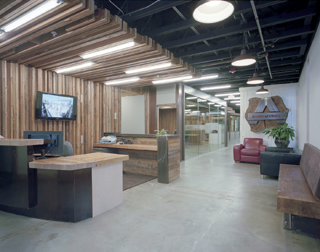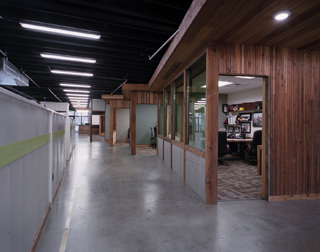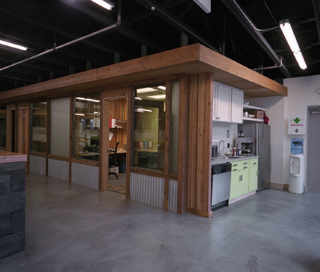|
Subscribe / Renew |
|
|
Contact Us |
|
| ► Subscribe to our Free Weekly Newsletter | |
| home | Welcome, sign in or click here to subscribe. | login |
Construction
| |
 |
March 29, 2012
One contractor’s trash is another’s office
Andersen Construction

Andersen
|
It is amazing where inspiration can be found, it is truly in everything and everywhere. We can trace the roots of our new office to a single wall that was built more than 80 years ago.
Over the past several years our office has been growing and it was time to expand. The search proved to be challenging as we wanted a space that afforded us some level of creativity, was close to downtown and fit more of the industrial style that we were comfortable with.
After much searching and near deals that fell short of closing, we found a space that met our needs at the old Puget Sound Blood Bank.
The space was nearly 6,000 square feet and had not been touched in years. It was largely warehouse and the small portion of interior build-out had long since expired in terms of function and design. It was perfect for our needs.
The only question that remained: “What do we want to do?”
An inspiration came from a tour of the newly renovated Rice Fergus Miller office in Bremerton. They had recently reconstructed an old Sears Automotive center and had done an incredible job.
While on the tour, I was walking up the main stairs with Mike Miller and the walls just struck me. The old lath and plaster had been demolished and what was left was the solid ganged two-by-four walls, raw and preserved 80 years after they had been nailed together. They were humble, but at every level it spoke to me as to the look and feel of what our new space needed to celebrate: the beauty and timelessness of construction in its raw form.
On the ferry ride back I called Elizabeth Maher, who had been working on several space plans for us, to tell her that I had found our inspiration. I described it to her and said we needed to build a wall in the new space to honor this vision.
I thought about it that night and felt that one wall just wouldn’t be enough, so I called her back the next day and said we needed to get at least two walls into the design. Her response to me was surprising in that I was not used to an architect thinking about the material procurement portion of the work, but she wanted to know if we had enough used material to build the walls. My response to her was that we needed to take a trip.
The trip
Between our yards in Seattle and Portland we have accumulated just about every imaginable item that you can think of over 60 years of operation. From leftover parts and pieces to windows that were removed during a renovation 25 years ago, we had it all.
What happened on that trip was really amazing. We looked at each other and thought the same thing: What if we could build the entire office out of recycled and reused materials? The idea of ultimate sustainable construction was really inspiring and became the rallying cry of everyone in our office as we moved forward into construction.
The goal was to create an open concept that allowed for the maximum amount of functional space and at the same time had the privacy of offices. Our space was also unique in that it was in a large building with few windows. A key focus was on natural day lighting and a view to the outside for all employees, which meant none of the closed-in offices could be against the windows.
Since getting materials to build the space were not a problem, the challenge of making the space functional and aesthetically pleasing became the fun part. Creating a consistent theme throughout the space was paramount and it had to feel as though we designed it first and then procured the materials; not the other way around.
Elizabeth did an amazing job of incorporating all of our miscellaneous parts and pieces into an incredibly functional and fun place that looks great. We set a goal to use 95 percent recycled, reused or re-purposed materials in the space, and I can proudly say that we achieved that.
Reusing
We had built a 30-foot-tall mock-up in our yard for an expansion to the Shriners Hospital for Children in Portland. The project finished and nobody wanted the mock-up, so we dismantled the pieces of glass weighing 4,600 pounds and made a conference room wall from them.
| Andersen’s Seattle office |
|
5,875 square feet Construction cost: $182,000 Start: Oct. 1, 2011 Finish: Jan. 18, 2012 Owner: Andersen Construction Co. Architect: Elizabeth Maher Architect Construction team: Joel Andersen, project manager Yates Osborn, project engineer Kyle Anderson, superintendent |
All of the wood in our space (which is almost everything) previously had another home. We built every wall inside the space out of solid ganged two-by-fours, some 25 years old. When we demolished the few existing walls in the space, we pulled every screw and nail out, then re-installed them elsewhere in the space.
Even our furniture is recycled. All of the desks are built out of old doors. Where the hardware once was became a perfect grommet hole for computer cords. Desk legs are made of wide-flange beams that once temporarily supported a derrick crane that sat on top of the Seattle Musical Theatre when we replaced the facade access equipment.
In our old office, we had built desks out of glu-lams. We pulled them out of that space and built tables and tops in various places in the new location.
Our receptionist sits at a refurbished desk purchased from a subcontractor that had a going-out-of-business sale. At that same sale, I bought 4,000 square feet of lightly used carpet tile thinking someday we would build out a space and we could use it. I bought that material more than three years ago and we moved it around our warehouse about a hundred times, but I knew we would use it someday.
We have two kitchens and both uses 100 percent recycled/re-used materials.
In our large conference room, we went to Second Use and bought kitchen cabinets that had come out of someone’s house. They look and work great. The countertop was made from broken pieces of quartz that were headed for the Dumpster when our tile installer spotted them.
In our kitchen area we reused kitchen cabinets for the uppers that came out of someone’s house from the 1970s or 1980s. We sanded them, painted them and installed new hardware. They turned out great. The base cabinets were from a high school chemistry class and had been lying around at Second Use.
Dishwashers were purchased from a private party when they were getting ready to upgrade. We reused sheet metal from demolished ducts to make new fronts for the dishwashers.
Our ceiling treatments were carefully thought out as well. For the main area’s soffit, we installed tongue-and-groove cedar that had been taken off someone’s house. It was painted gray, so after installation we sandblasted to expose the beautiful natural cedar from years before.
All of the ceiling grids were recycled from various interior renovation projects and all of the ceiling tiles were remnants from different jobs. While an individual office ceiling has the same look, no two office ceilings are the same.
Others climb on board
It was a lot of fun to engage the subcontractors as well. Forest Sound Products, who handled all of our ceilings, found a number of acoustical wall panels that had been installed in different schools over the years. We re-used them in offices for sound attenuation and created a unique look.
We have long used mock-ups as a way to see how things come together and work, but they often get left for the garbage can. One of our senior project managers had a job that used demountable partitions that had to be mocked up. He suggested that we use them permanently in our new space as a showpiece to this client and future others. It worked out great and they become the fronts to our special projects department area.
Even our lighting was recycled. We cleaned up every light that was in the space and then re-used lights from other projects that we were renovating.
It was a great project for exploring ideas from all of our people, with anything possible. All of our jobsites were calling in and saying, “Hey we have this left over, do you want it?” or “I’m renovating this one space and we have 16 pendant lights, can we use them at the office?”
In addition to creating an ultra-sustainable, functional and fun work environment, our approach made it incredibly affordable. We built out our space for around $30 a square foot, which is incredible considering that we are going for LEED silver certification!
It was a truly a once-in-a-lifetime project and amazingly fun and inventive to build.
Joel Andersen opened Andersen Construction’s Seattle office in 2008 and is the Seattle division manager. His grandfather formed Andersen Construction in 1950 and his father is president of the Portland-based company.
Other Stories:
- Nurturing tomorrow’s construction leaders
- 2012 Construction Surveys: JE Dunn Construction
- 2012 Construction Surveys: Rushforth Construction
- 2012 Construction Surveys: Walsh Construction
- 2012 Construction Surveys: Pease Construction
- 2012 Construction Surveys: W.G. Clark Construction Co.
- Follow these 4 'safety truths' to reduce injuries
- BIM evolves into a safety tool
- Claims clauses: Mike Johnson case is here to stay
- Is your software holding you back?
- Contractors sidestep the bonding blockade
- Washington rolls out new crane regulations
- Succession planning begins at the top
- 2012 Construction & Equipment Surveys





